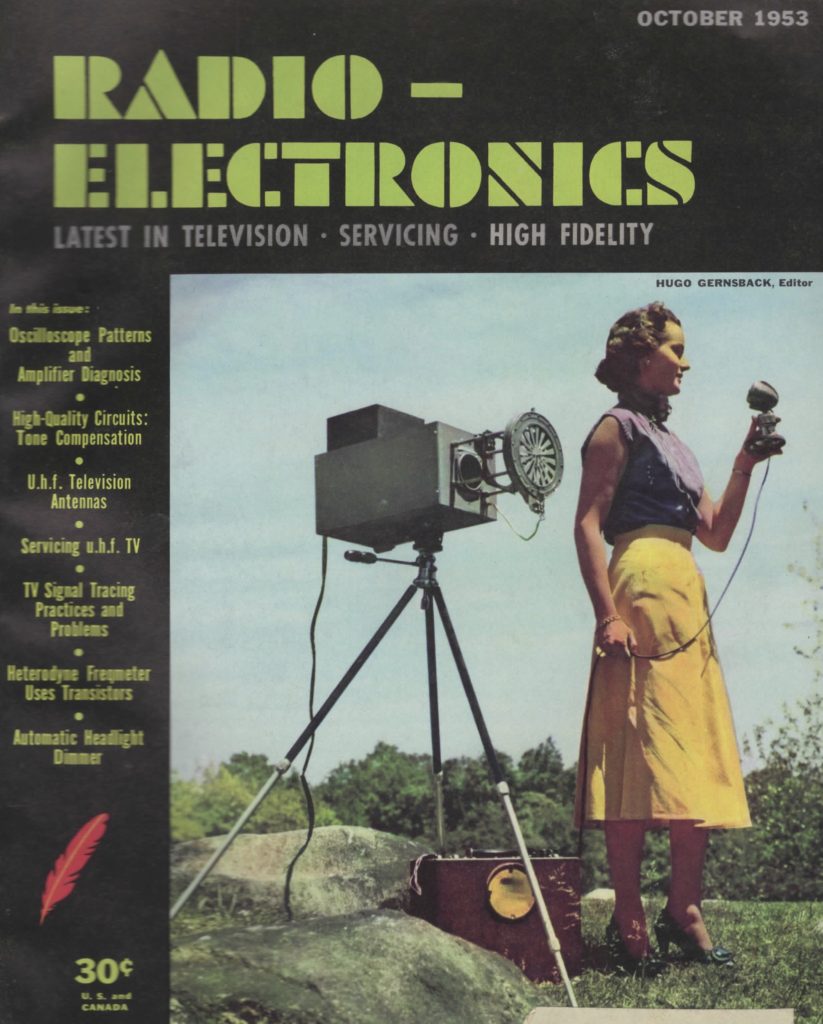
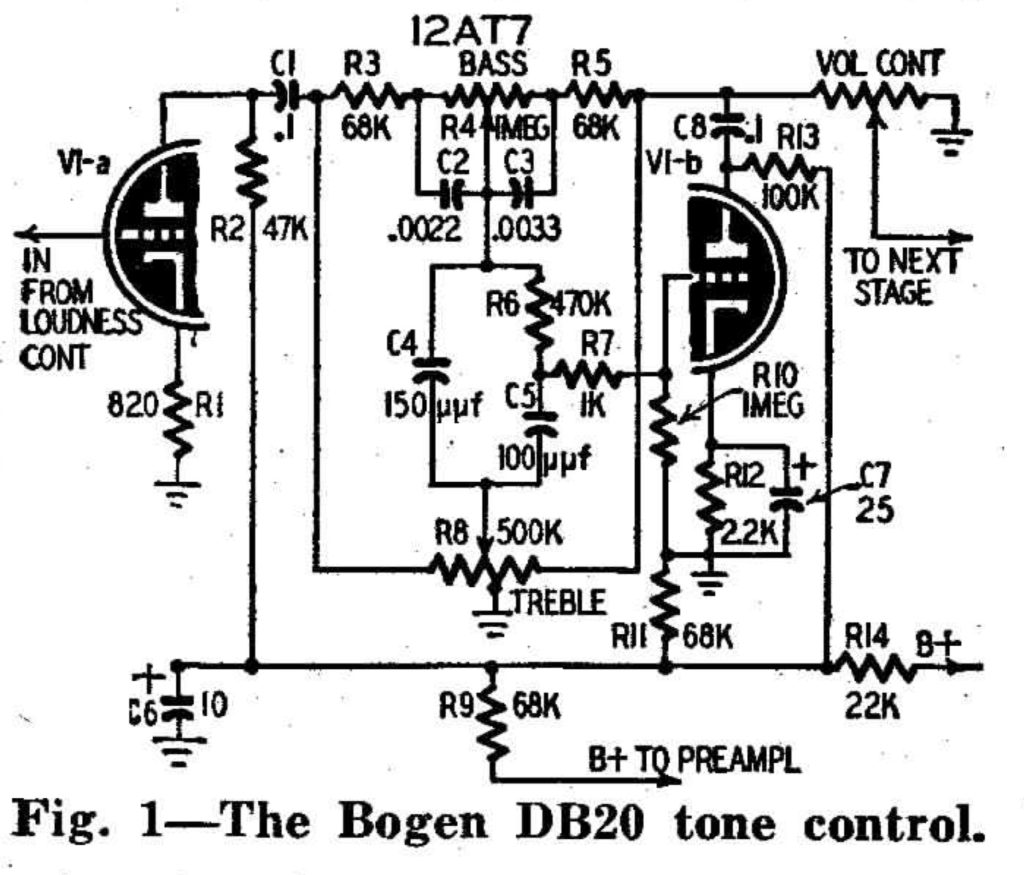
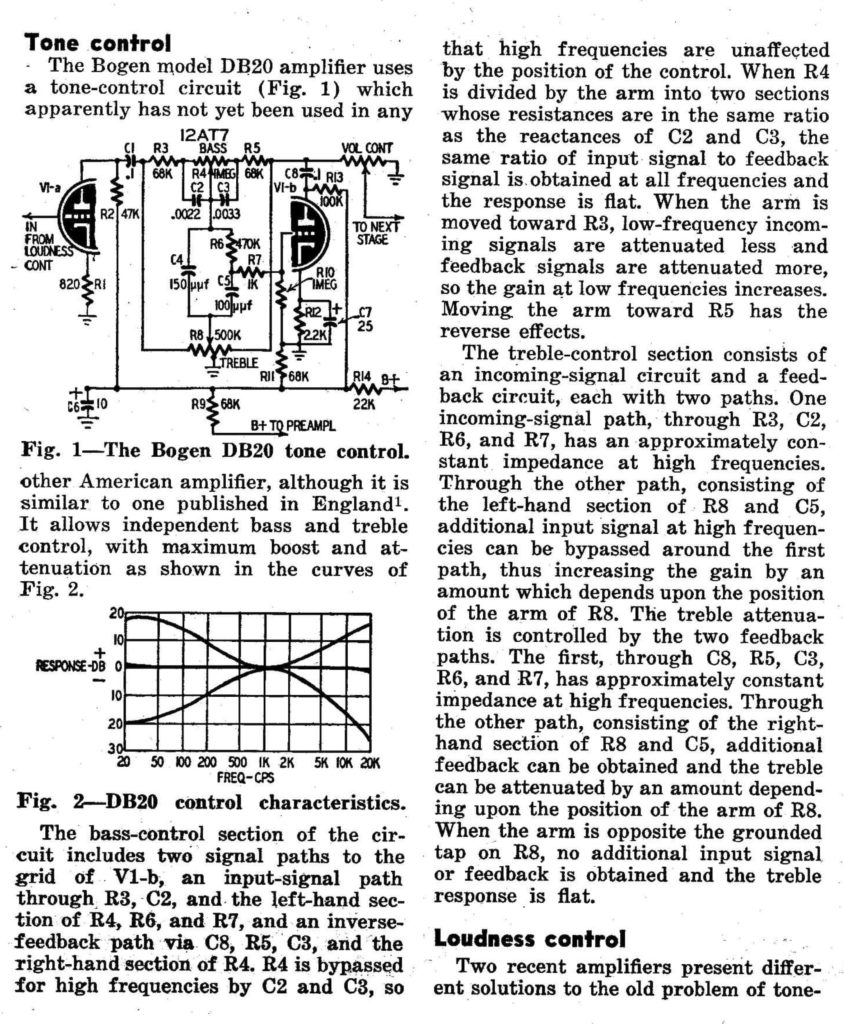



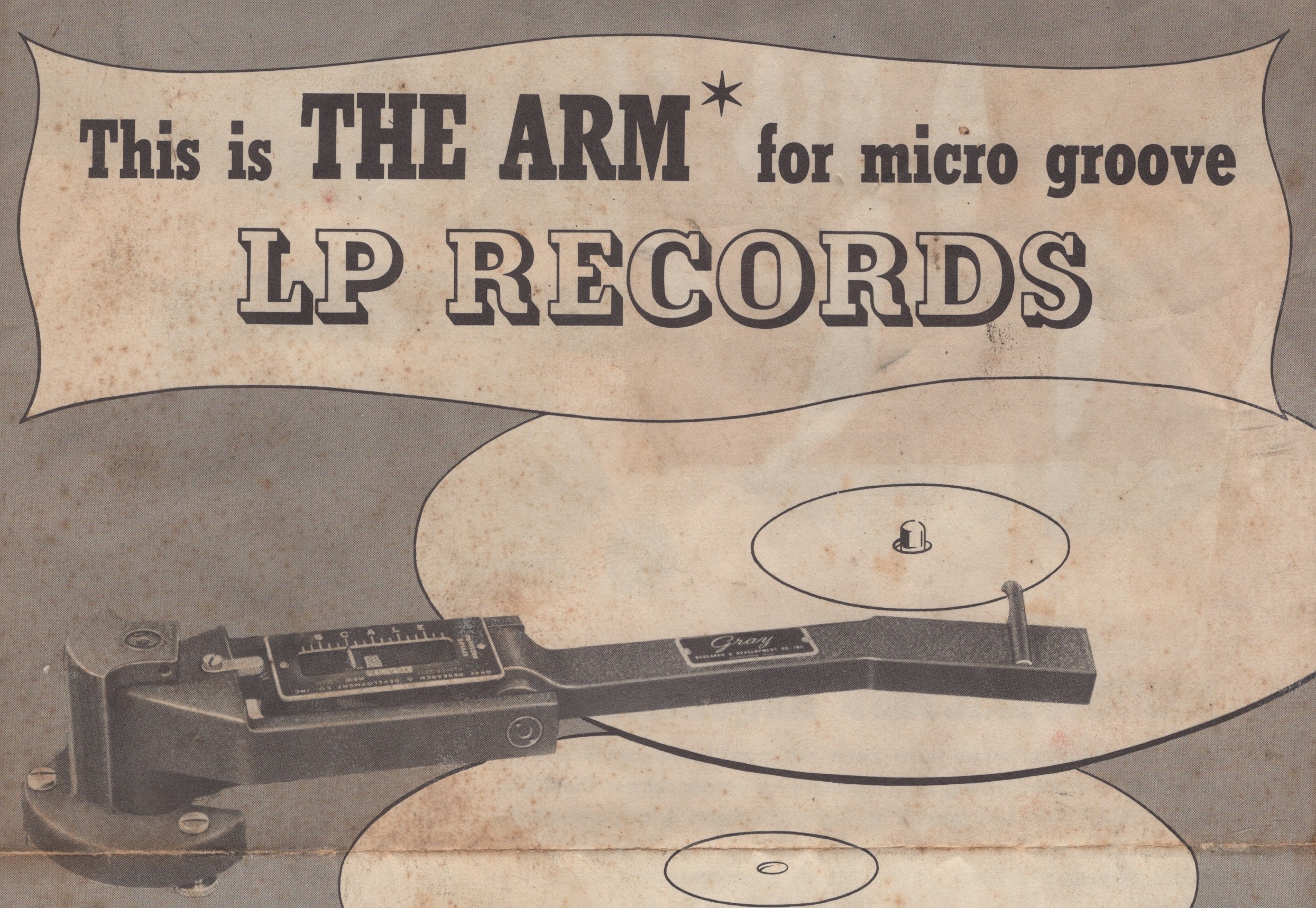 download the 4pp circa 1950 Gray Research sales flier for the model 103-LP Transcription Arm and the model 602 disc equalizer:
download the 4pp circa 1950 Gray Research sales flier for the model 103-LP Transcription Arm and the model 602 disc equalizer:
DOWNLOAD: GrayResearch_103_602
Gray was located in Hartford, CT, just a stone’s throw from here, from roughly 1950 through 1970. feel free to correct me if you personally know otherwise. I have come across very little original Gray literature and equipment in my 13 years here.
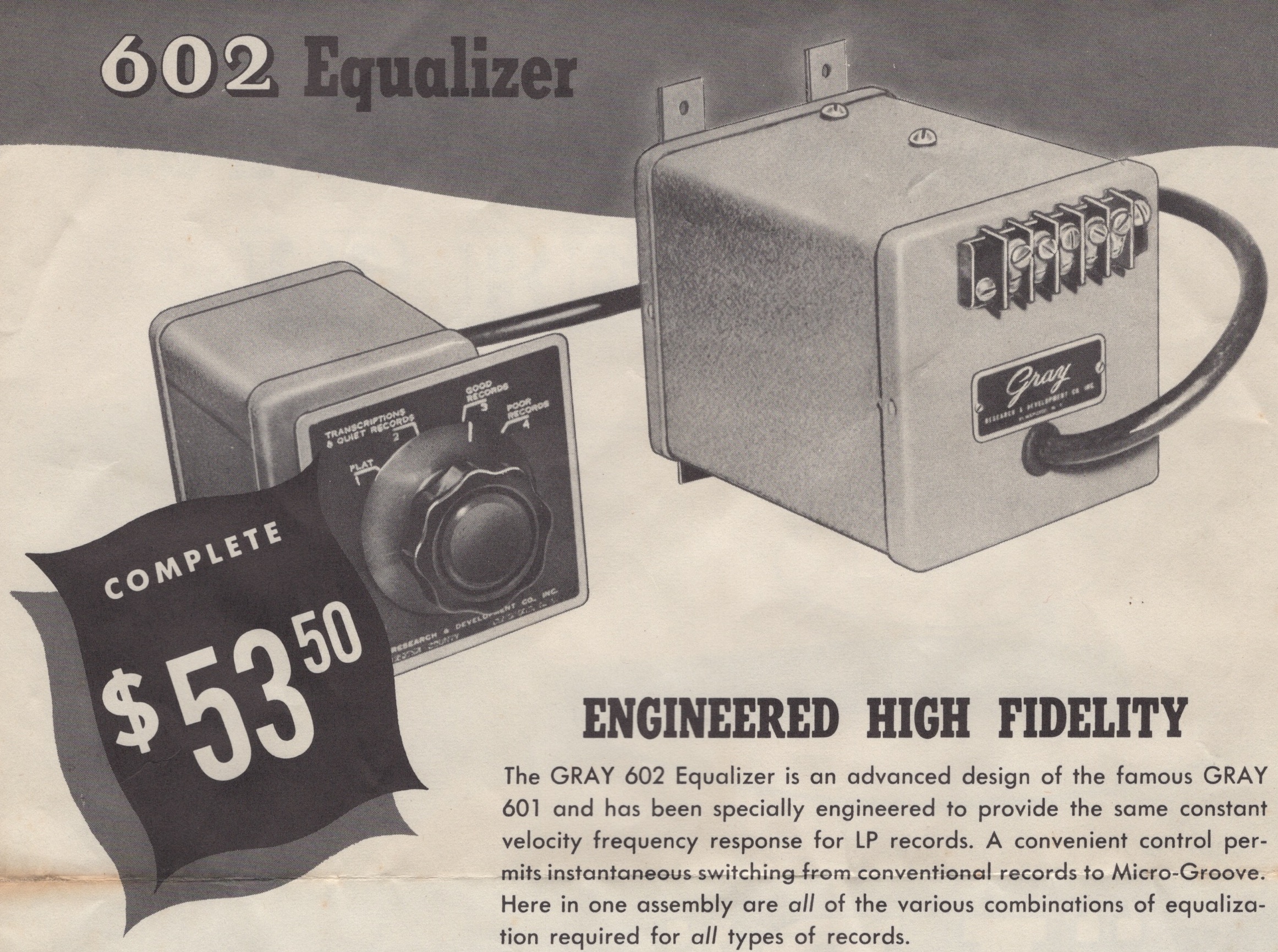 There seems to be very little information on the internet about this company, other than this nice archive.
There seems to be very little information on the internet about this company, other than this nice archive.
If you or a family member worked at Gray, please drop us a line.
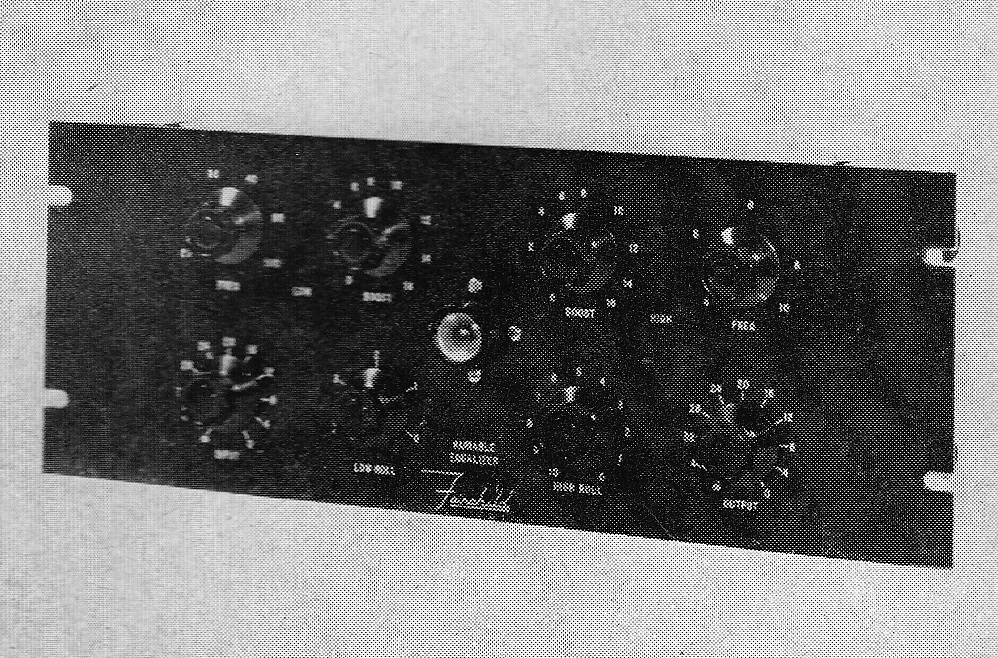 Apologies for the poor image quiality; these came from the research department of a long-gone British broadcast-gear-manufacturer via some dampish papers that I purchased recently from a rare-books-dealer in London. I had never heard of the Fairchild 627 ‘Variable Equalizer,’ even though I recently sold an example of its (even-more-rare) predecessor the model 540, which in retrospect seems to be the ‘boost’ sections of the 627 plus a mic preamp plus a 20-watt cutter-head power amp. Well shit. Now i wish I had measured the values of the triple-ganged frequency-select pots. Why? We will get to that in a minute.
Apologies for the poor image quiality; these came from the research department of a long-gone British broadcast-gear-manufacturer via some dampish papers that I purchased recently from a rare-books-dealer in London. I had never heard of the Fairchild 627 ‘Variable Equalizer,’ even though I recently sold an example of its (even-more-rare) predecessor the model 540, which in retrospect seems to be the ‘boost’ sections of the 627 plus a mic preamp plus a 20-watt cutter-head power amp. Well shit. Now i wish I had measured the values of the triple-ganged frequency-select pots. Why? We will get to that in a minute.
A quick google search suggests that there are thought to be only 5 Fairchild 627 equalizers in existence. One seems to have sold on eBay recently in the $7000 region. The 627 is a line-level EQ with continuously variable low and high bell boost sections as well as high and low roll offs. Unlike a Pultec, though, it is an active EQ, and it uses some pretty unusual circuitry – especially the high-cut section, which I don’t comprehend at all.
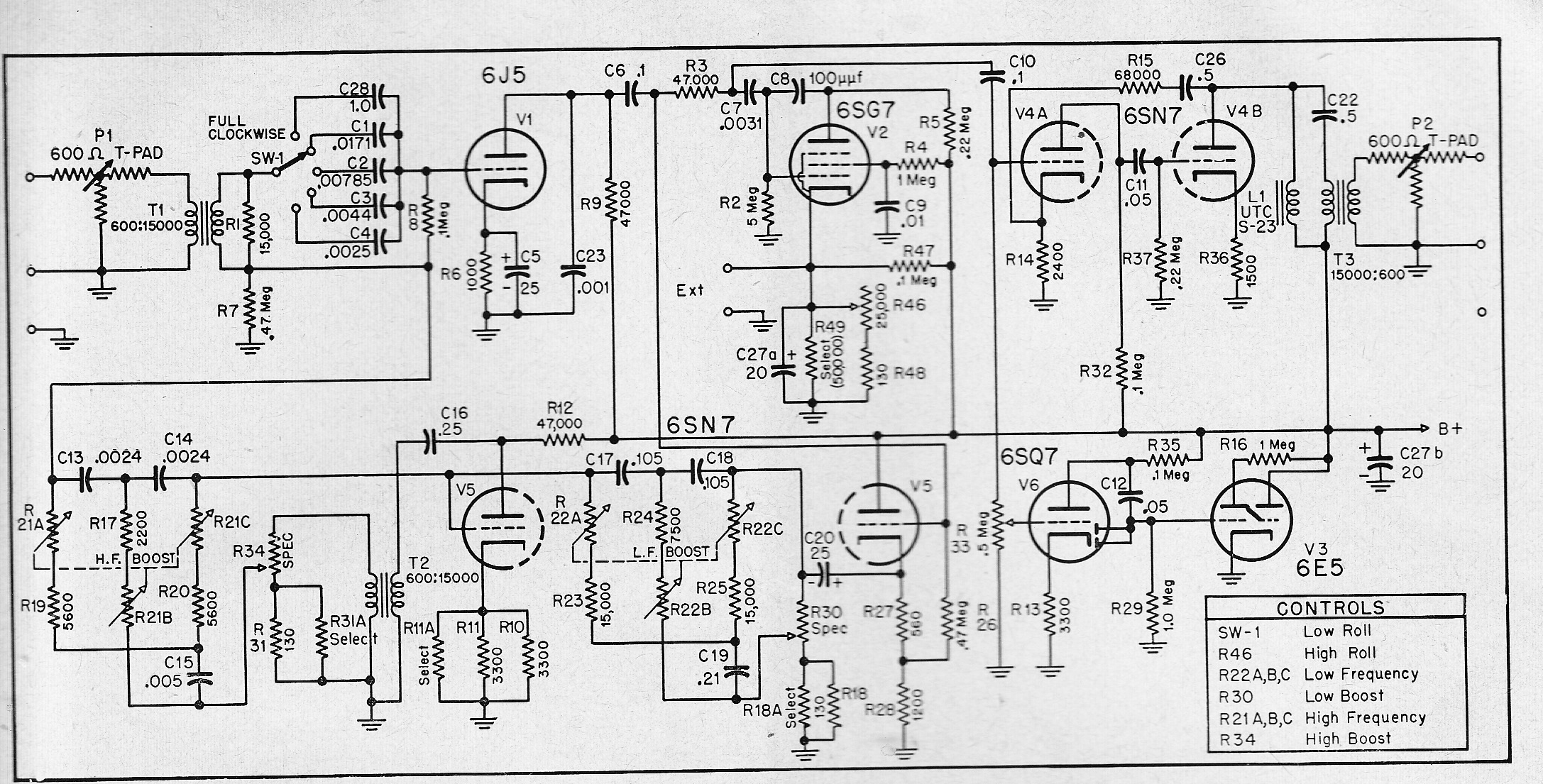 One point to note: T2 should be wired to reverse phase. I was v excited to find this schematic, because it seems like a pretty easy piece to build – there is no mention of the proper B+ voltage, but 250 is generally a safe bet; there are no weird inductors (the UTC S-23 plate-load choke is an off-the shelf part, so we know its specs -5000ohm DC, 300 henries); the audio transformers don’t need to handle DC and the turns ratios are spec’d: BUT: But. Those triple-ganged pots. WTF do we do about them?
One point to note: T2 should be wired to reverse phase. I was v excited to find this schematic, because it seems like a pretty easy piece to build – there is no mention of the proper B+ voltage, but 250 is generally a safe bet; there are no weird inductors (the UTC S-23 plate-load choke is an off-the shelf part, so we know its specs -5000ohm DC, 300 henries); the audio transformers don’t need to handle DC and the turns ratios are spec’d: BUT: But. Those triple-ganged pots. WTF do we do about them?
Can anyone crack this case? Any insights, pls let us know in the comments section.
On the plus-side: at very minimum, this schematic does reveal an excellent and easy way to implement a 6E5 seeing-eye tube simply paralleled to a grid in the audio path. So at very least, now i know how to use those v excellent things in my mic preamps. Way more evil than a VU meter.
Also: the 6SN7 output section is a neat little self-contained module; def worth trying it with a Hammond 156C choke and an Edcor 15K:600 1/2 watt. The 156C is the closest modern part to the S23 spec; it is rated 150h and 3.7K ohm, seems close enough? I used onna these on a hunch in my OP6-semi-clone and it worked just fine in that application, so I am guessing it may work fine here as well. 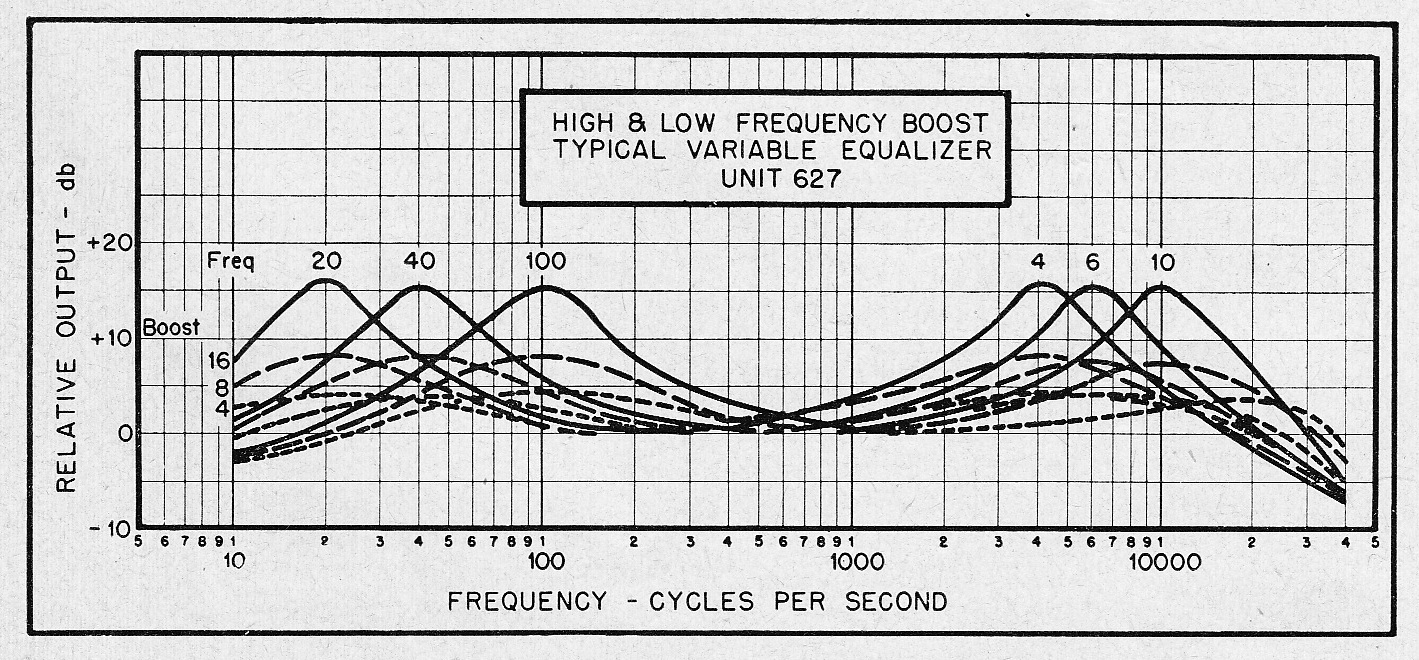
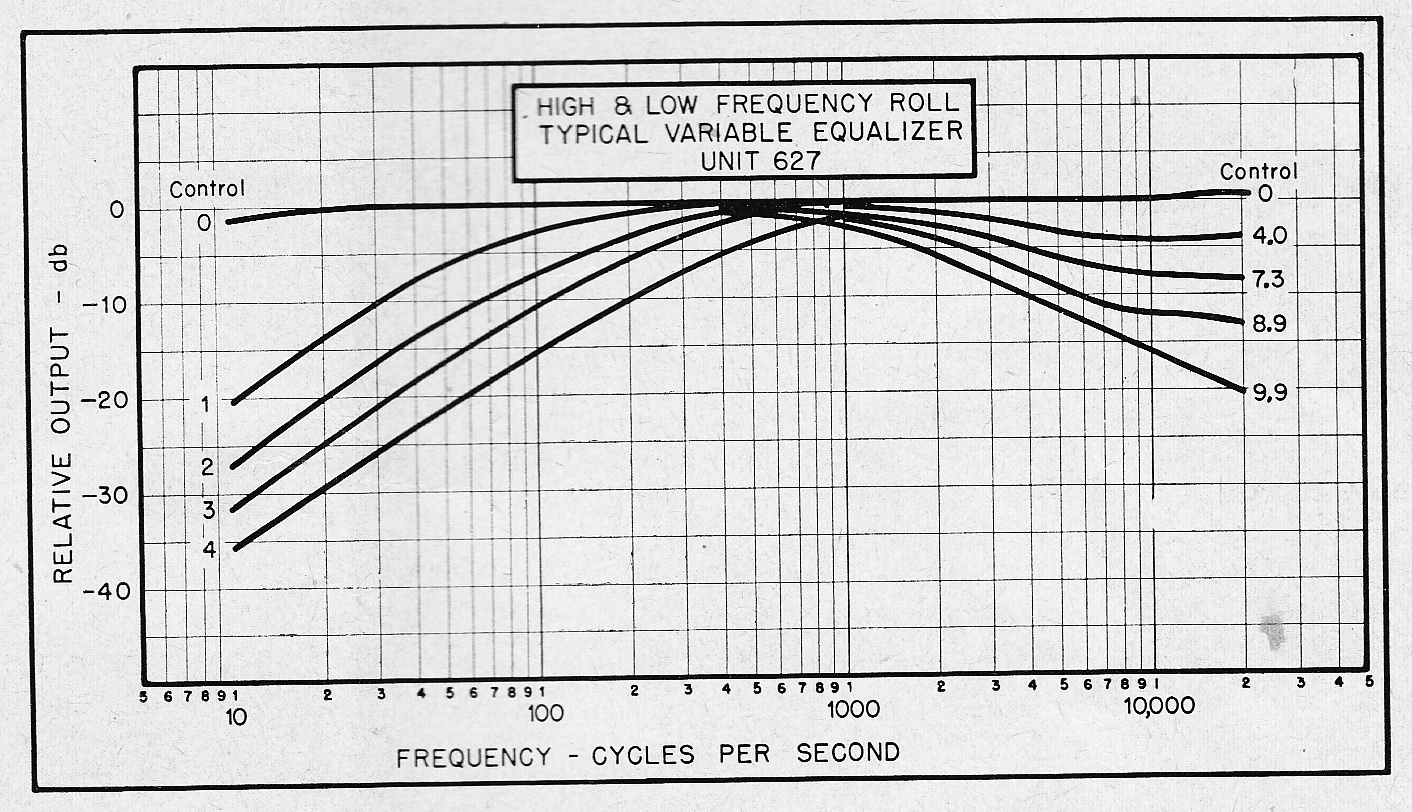
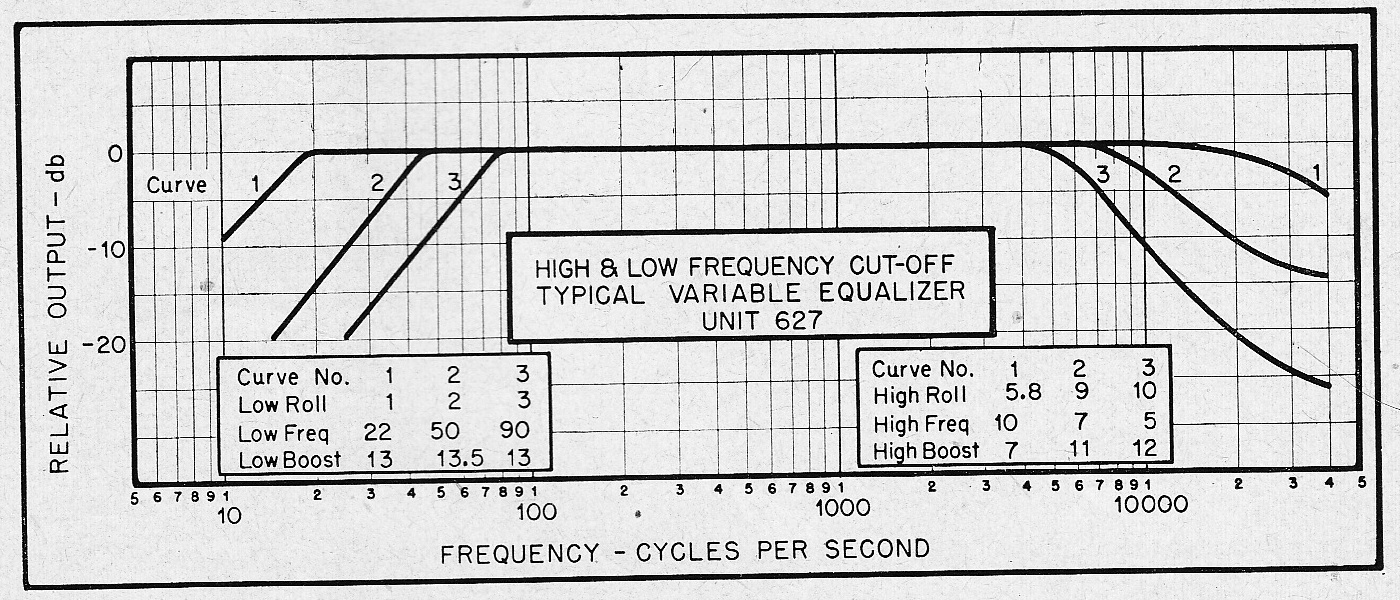
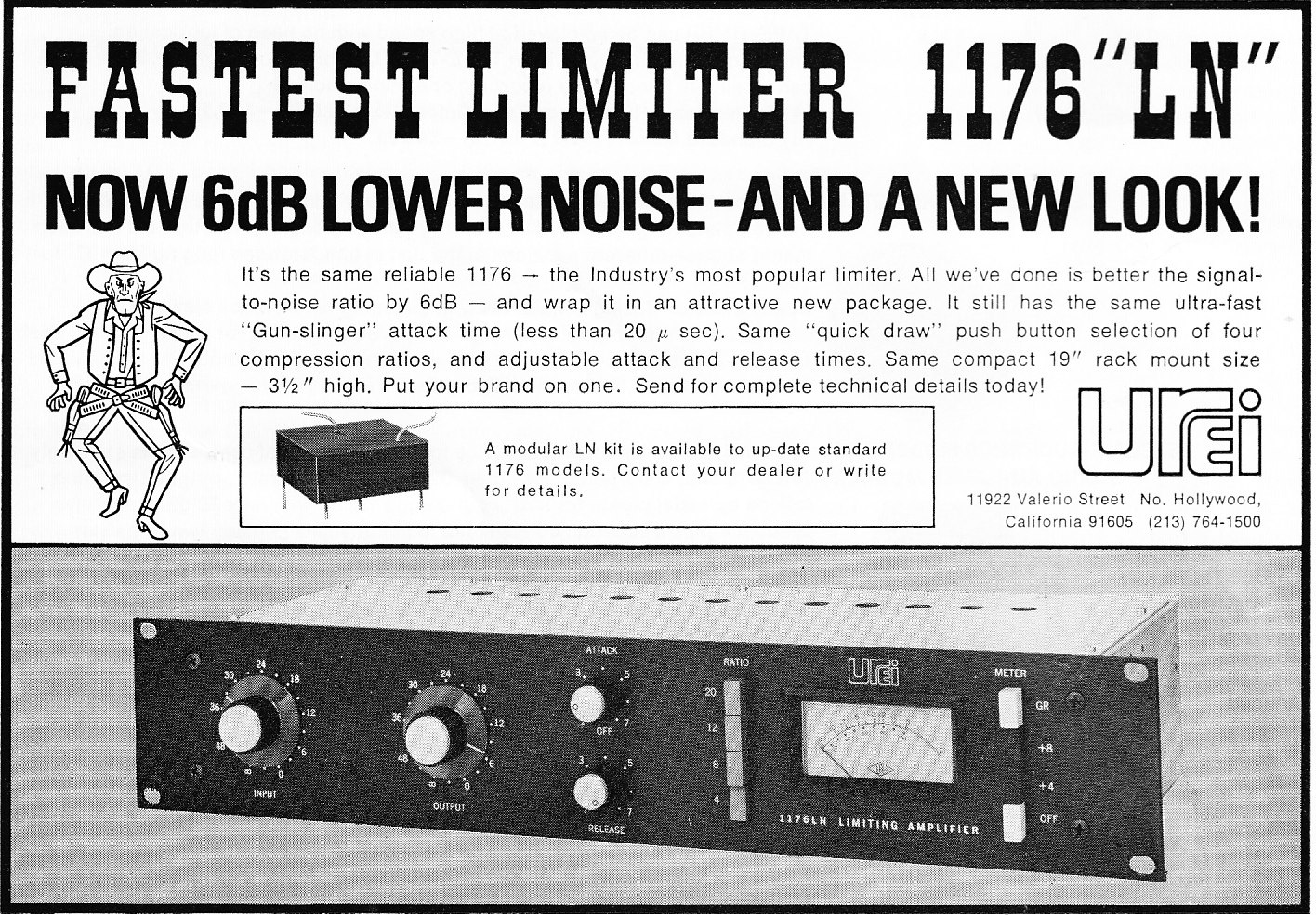 Today: just a few things that caught my eye from ’71 -’73: the ‘new’ black-cosmetic version of the Urei 1176, plus some odd bits from Soundcraftsmen and Sansui (I had no idea that they had made pro audio products), and another forgotten Quad-Eight rack device (see here for our earlier coverage of their very obscure reverb unit). Also something called the ‘OP Reverberation’ …. anyone? ,,,and a few unusual items from Martin. Wrapping it up is the annoucement ad for the original API 525C, which has become one of my favorite compressors for vocals since we got one at Gold Coast Recorders. If any of y’all are using the Martin or Quad-Eight kit, let us know!
Today: just a few things that caught my eye from ’71 -’73: the ‘new’ black-cosmetic version of the Urei 1176, plus some odd bits from Soundcraftsmen and Sansui (I had no idea that they had made pro audio products), and another forgotten Quad-Eight rack device (see here for our earlier coverage of their very obscure reverb unit). Also something called the ‘OP Reverberation’ …. anyone? ,,,and a few unusual items from Martin. Wrapping it up is the annoucement ad for the original API 525C, which has become one of my favorite compressors for vocals since we got one at Gold Coast Recorders. If any of y’all are using the Martin or Quad-Eight kit, let us know!
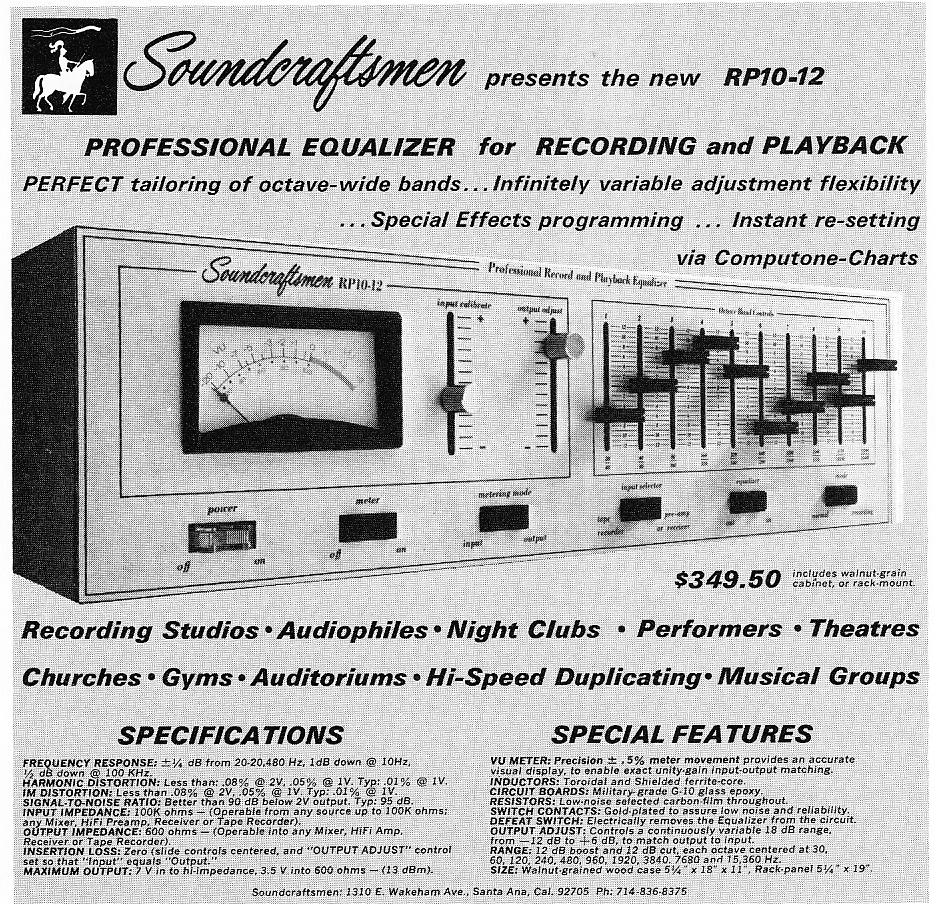 Above: The Soundcraftsmen RP10-12 equalizer
Above: The Soundcraftsmen RP10-12 equalizer
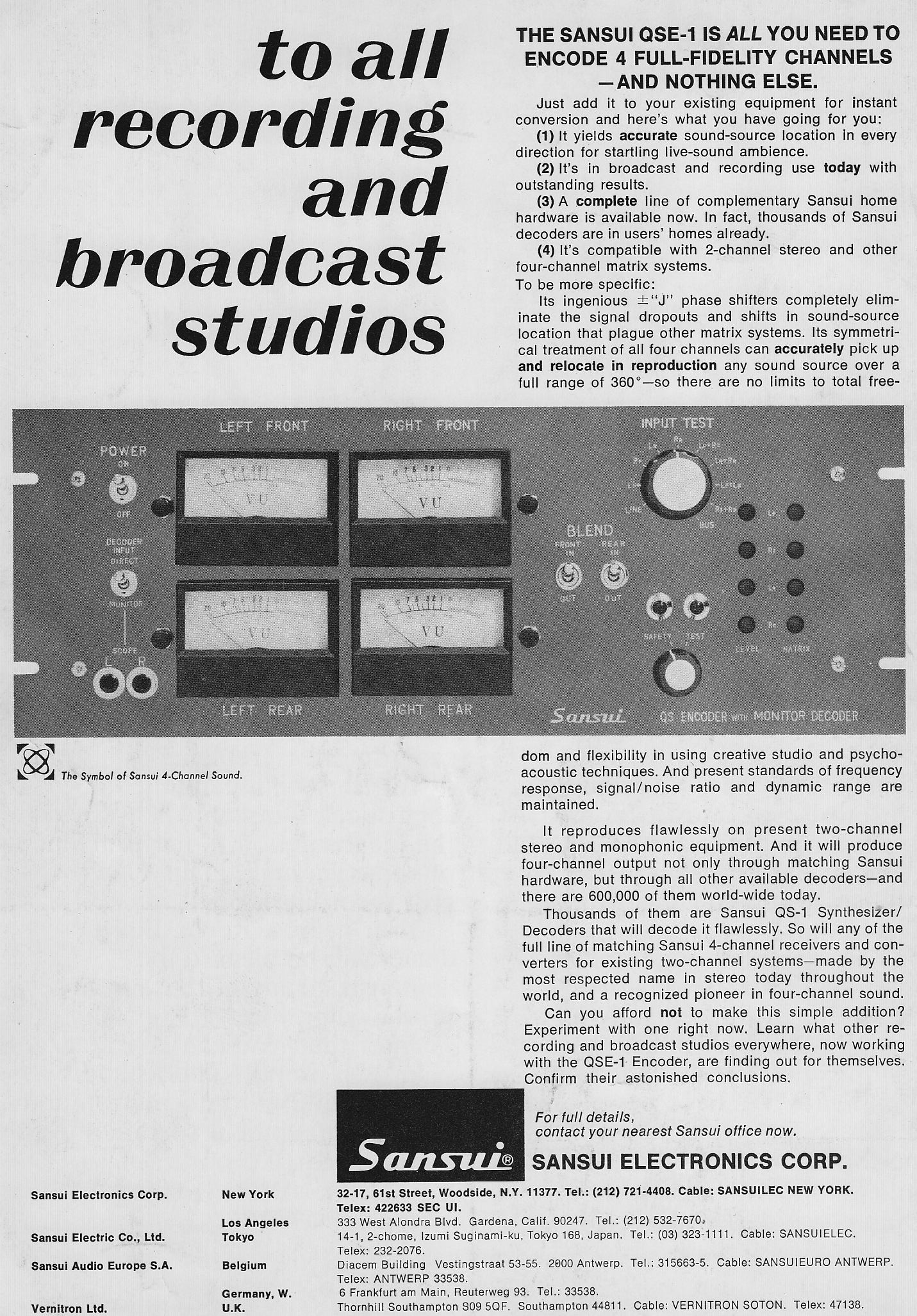 Above: The Sansui QSE-1 Quadraphonic Encoder
Above: The Sansui QSE-1 Quadraphonic Encoder
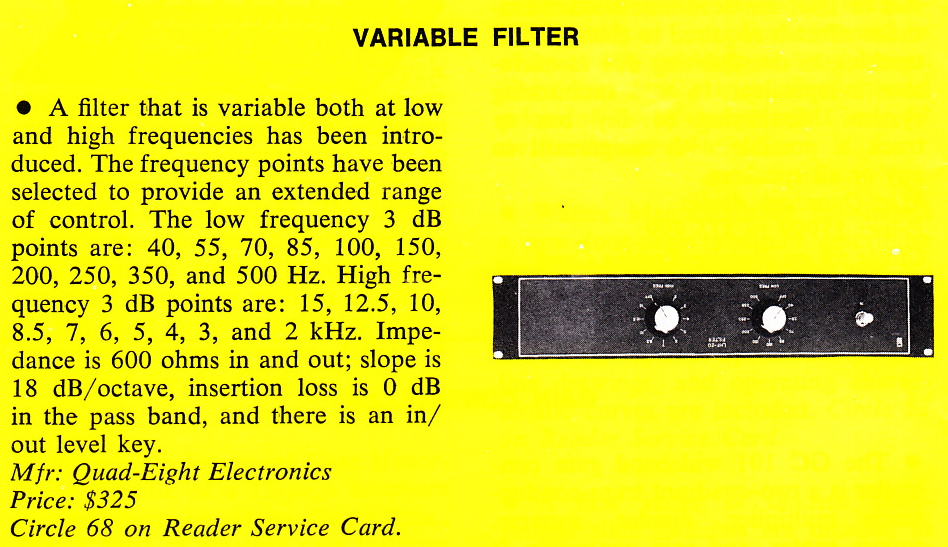
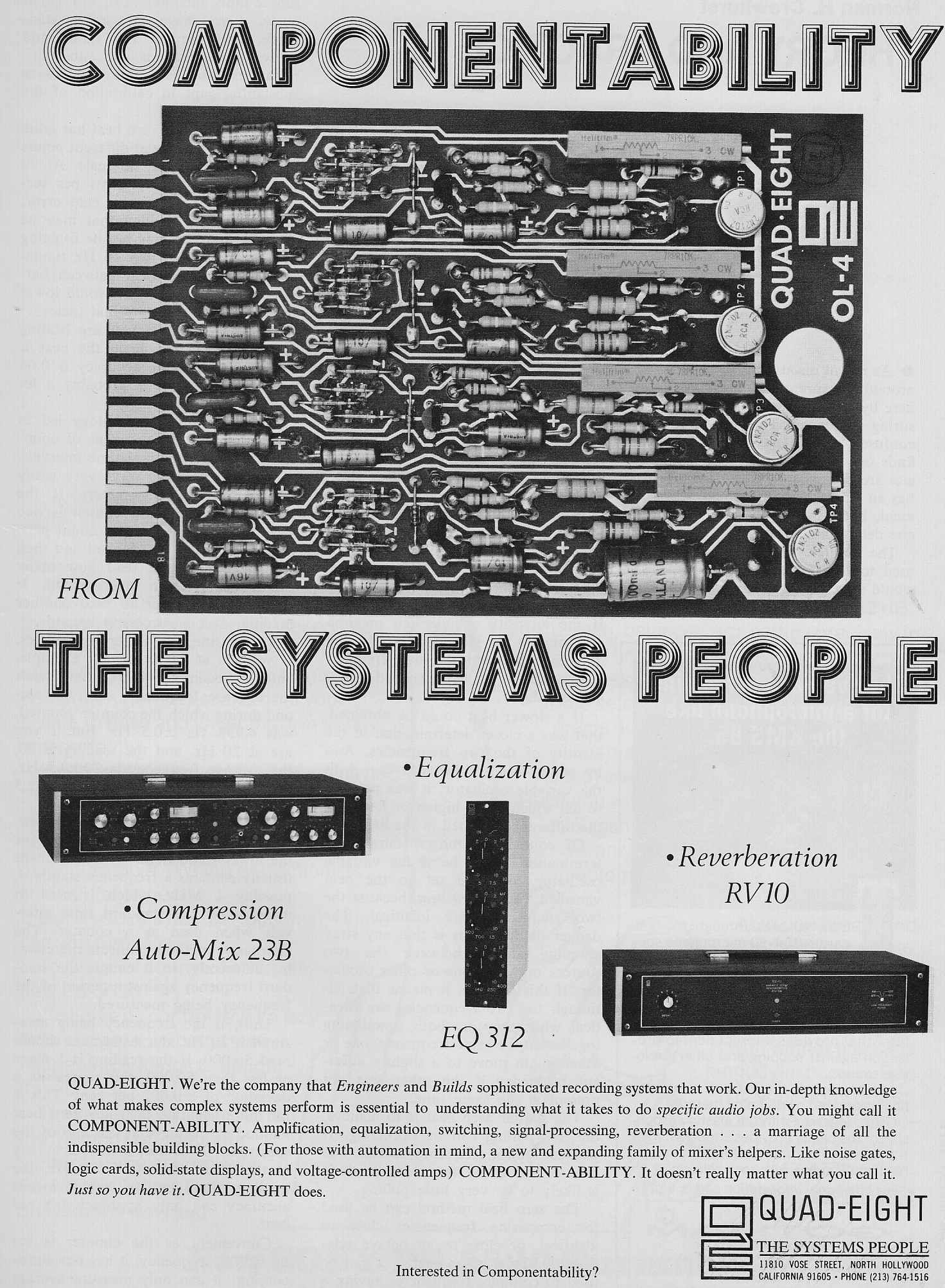 Above: The Quad-Eight Variable Filter, Auto-Mix 23B compressor, EQ 312 channel EQ, and RV10 Reverb unit
Above: The Quad-Eight Variable Filter, Auto-Mix 23B compressor, EQ 312 channel EQ, and RV10 Reverb unit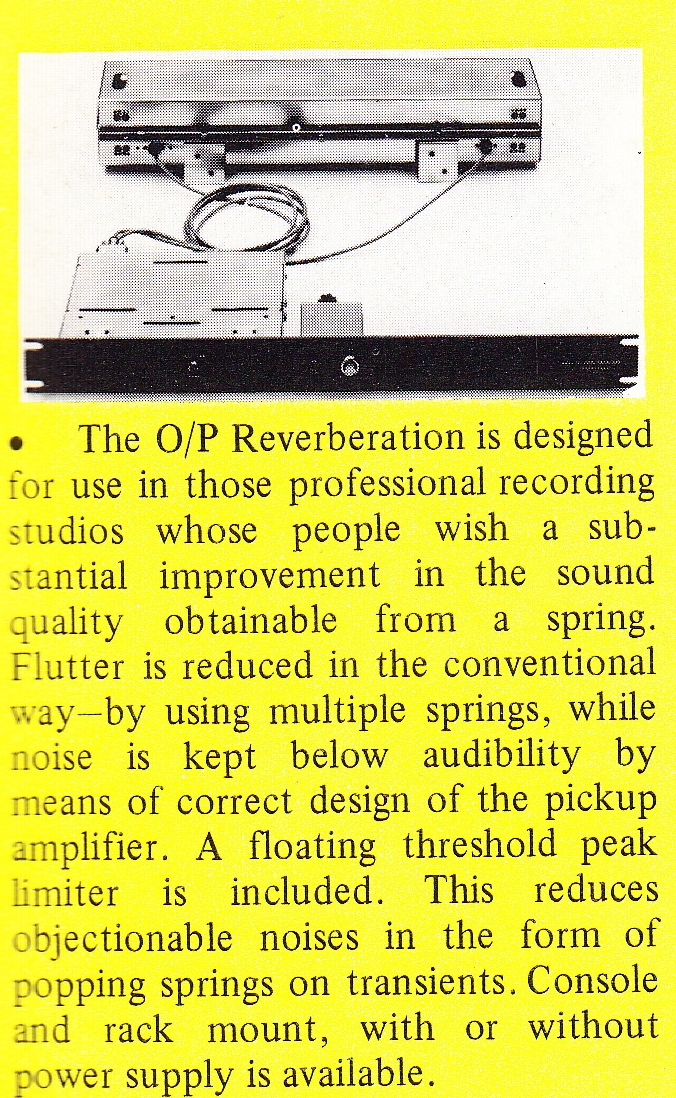
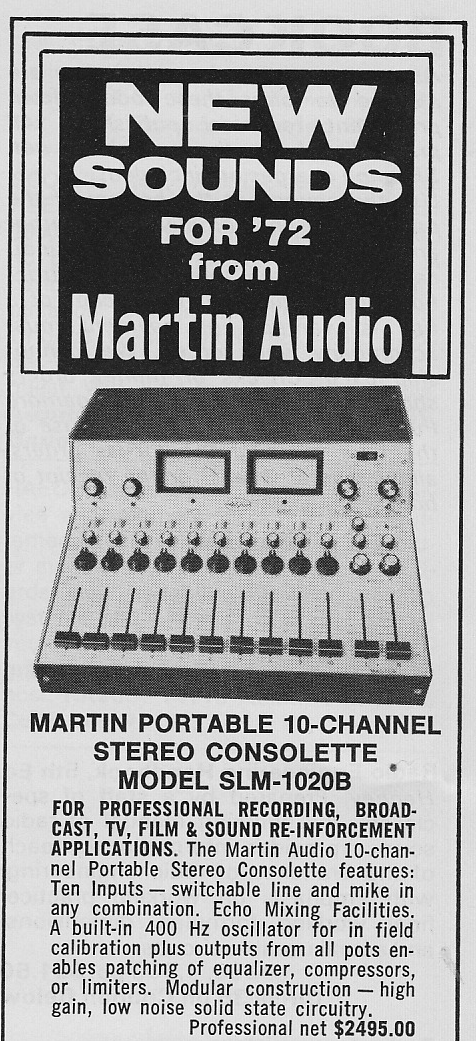
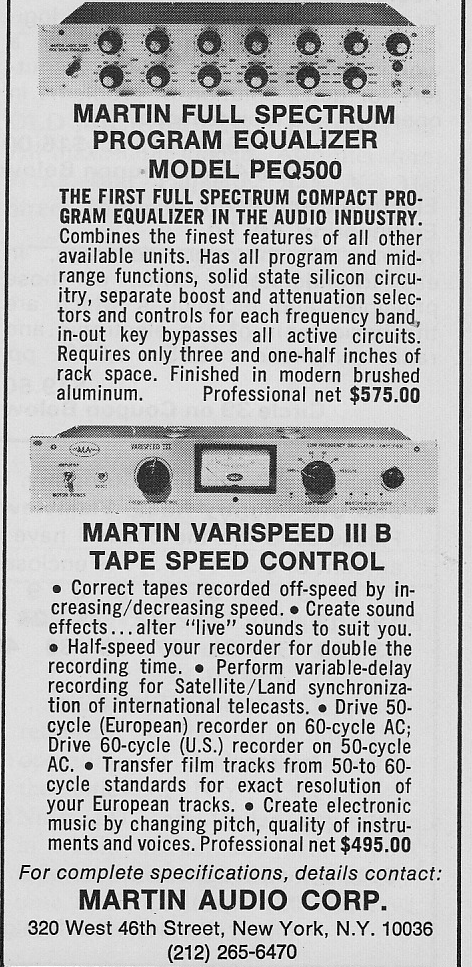 Above: the Martin SLM-1020B mixer, PEQ500 rackmount program EQ, and varispeed 3B tape machine speed controller.
Above: the Martin SLM-1020B mixer, PEQ500 rackmount program EQ, and varispeed 3B tape machine speed controller. 
 Download the original 2pp product sheets for the 1978 ADR E900 and E950 equalizers:
Download the original 2pp product sheets for the 1978 ADR E900 and E950 equalizers:
DOWNLOAD: ADR_Eqs_1978
Last ADR thing for a while, I promise. OK Discuss amongst yrselves…
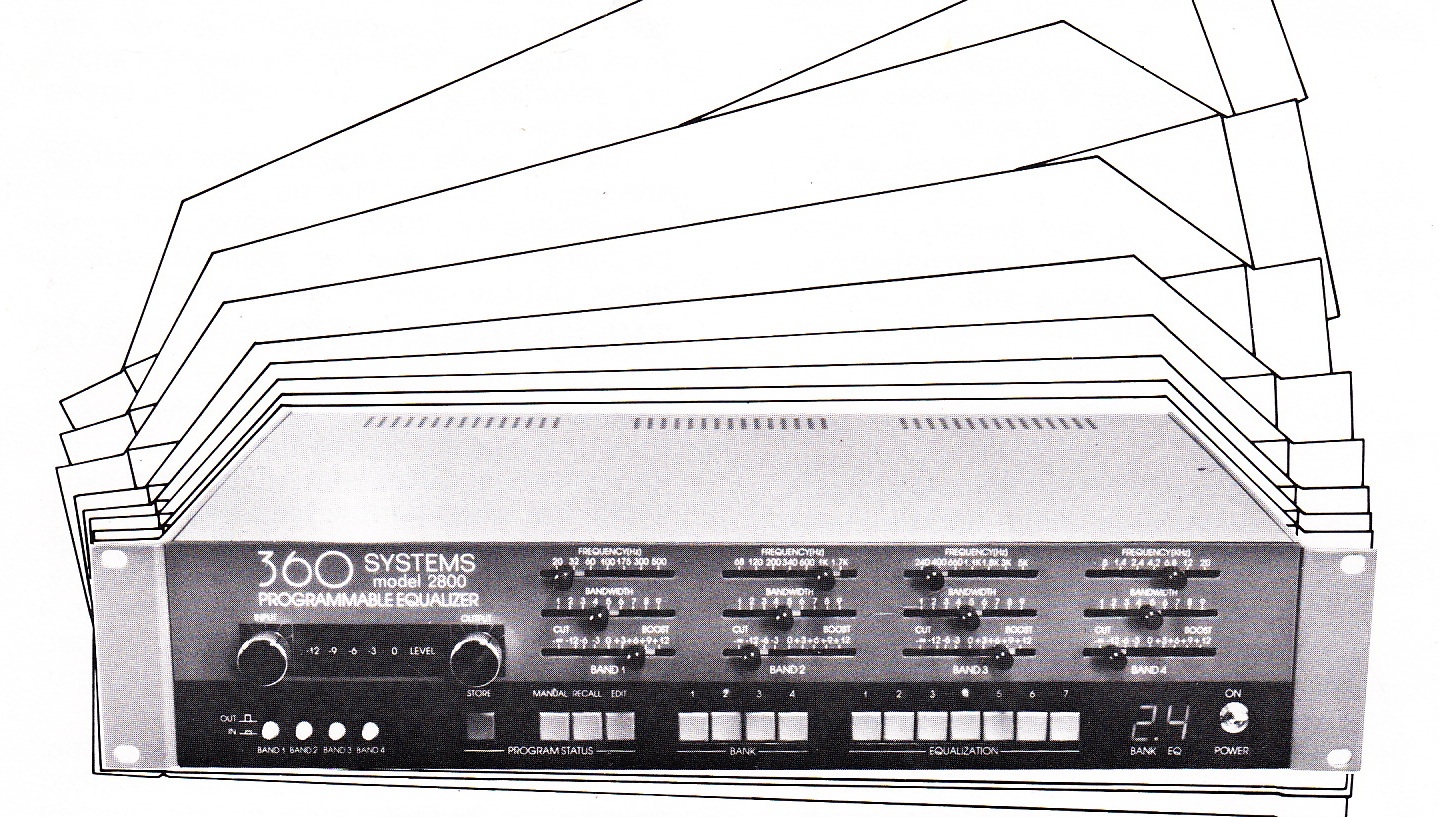 Download the 2PP spec-sheet for the very obscure 360 systems Model 2800 programmable 4-band parametric EQ:
Download the 2PP spec-sheet for the very obscure 360 systems Model 2800 programmable 4-band parametric EQ:
DOWNLOAD: 360_EQ
Four channels, fully parametric, with filters that offer +12 db/ -infinity (notch) operation, and 28 memory locations. The pre-plug-in plug-in. Anyone?
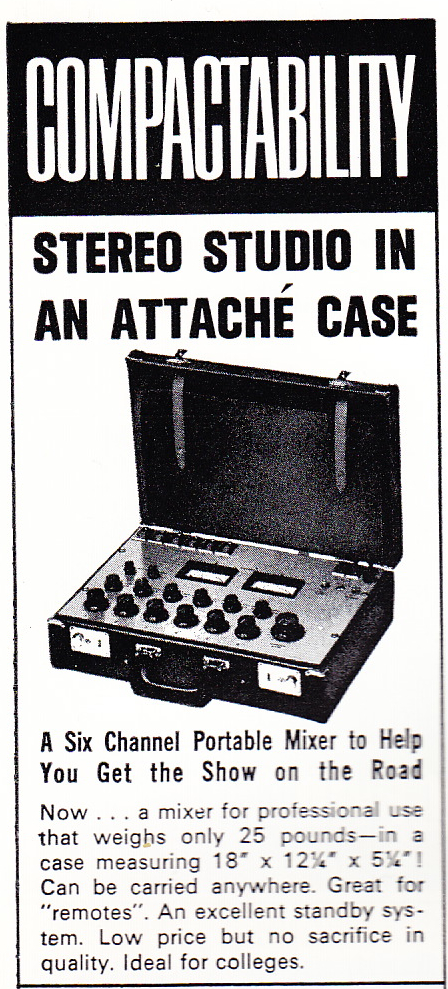 Above: Gately’s Stereo Briefcase Mixer circa 1970.
Above: Gately’s Stereo Briefcase Mixer circa 1970.
Gately Electronics was a Pennsylvania-based pro-audio manufacturing and importation/ distribution operation which seems to have operated between 1968 and 1975. I often noticed adverts for their EM7 mixer in the old AES journals; the EM7 had a sort-of Pultec or maybe LANG vibe, and I was curious enough that when I found one AS-IS for $100 on eBay I went for it. You can read my account of restoring my EM7 and its attendent EQ7 outboard equalizer accessory at this link. The short version: it is a very well-built machine, and I was therefore surprised that Gately seems to be completely forgotten in the pro audio world. Anyhow, I noticed that a pair of AS-IS Gately 1800 compressor cards went for an absurd amount of money on eBay last month, so I figured that maybe the world does need to know. I therefore present: every piece of period documentation that I could find on Gately Electronics, its products, and operations. Enjoy, and let us know if you are using any of this kit nowadays.
Above, from top to bottom: Gately ProKit 6-channel mixer (available as kit or assembled!), Gately’s Moms Wholesome Audio live PA board, Gately ProKit 2 mixer, and Gately EQ-6 and EK-6 equalizer and reverb accessories for the Pro-Kit (confused yet?). Below that, John Yoder of Hope Recordings recommends the Gately C1616 studio console. Next is an advert announcing Gately’s distribution of Ortofon lathes and Schoeps mics (yes please). Finally we see the Gately Micromixer, which appears to perhaps be the same as Moms Wholesome Audio Mixer?
*****************************************************************
***********************************************************************
Above: the Gately EM7 and EQ7, as described in my earlier article, followed by the subsequent updated versions EM7s and PEQ7. The PEQ7 seems to have exchanged th fixed hi-shelf control of the EQ7 for a five-frequency high bell curve EQ. Low frequency control is presumably still a shelf-type. I can’t find any other info on the ES-7 echo unit.
In 1974 a writer from DB (I imagine Woram or Zide; no credit is indicated) traveled to Gately’s Philadelphia-area facility.
You can download the account of their trip at this link: Gately_DB_Feb74
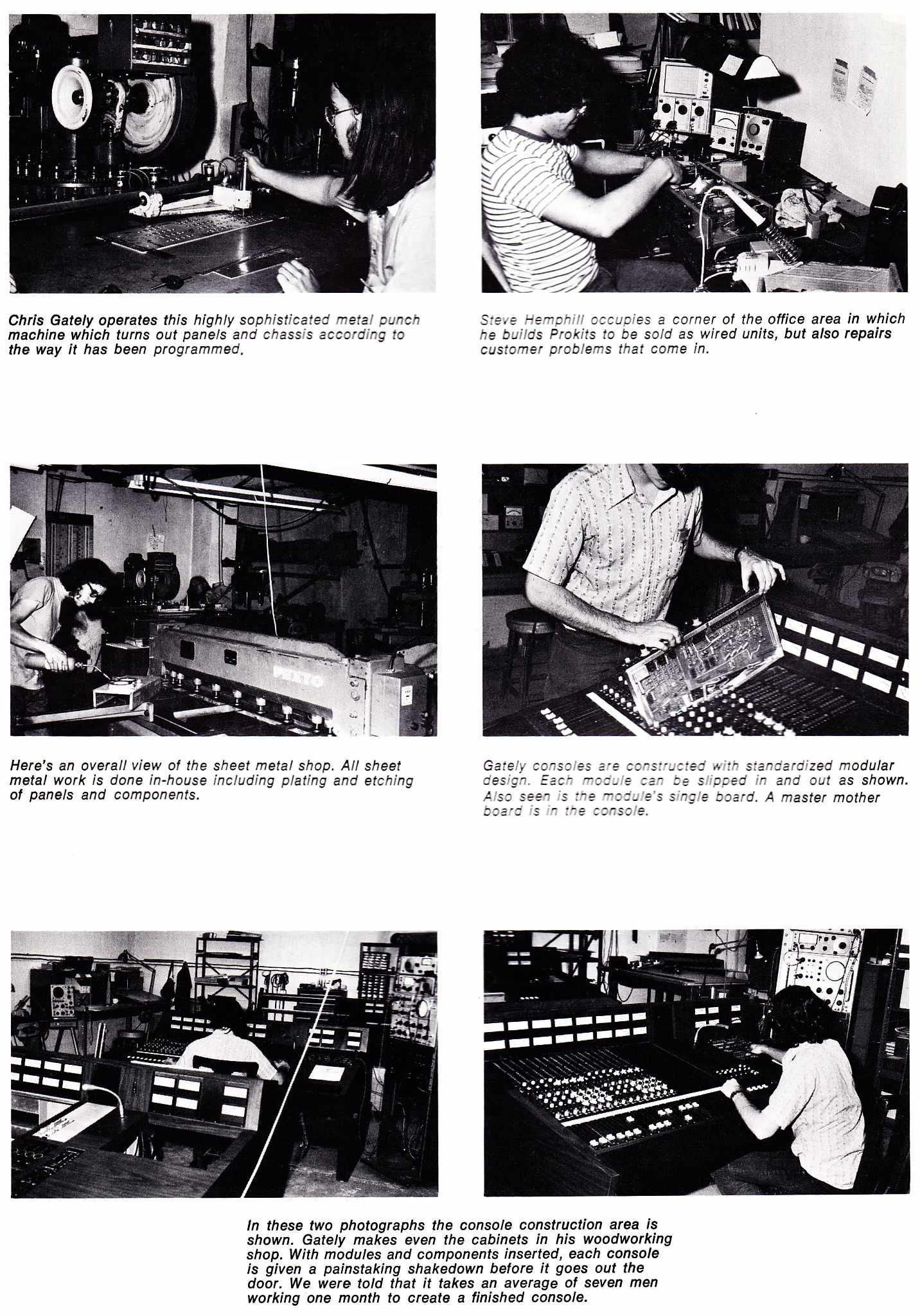
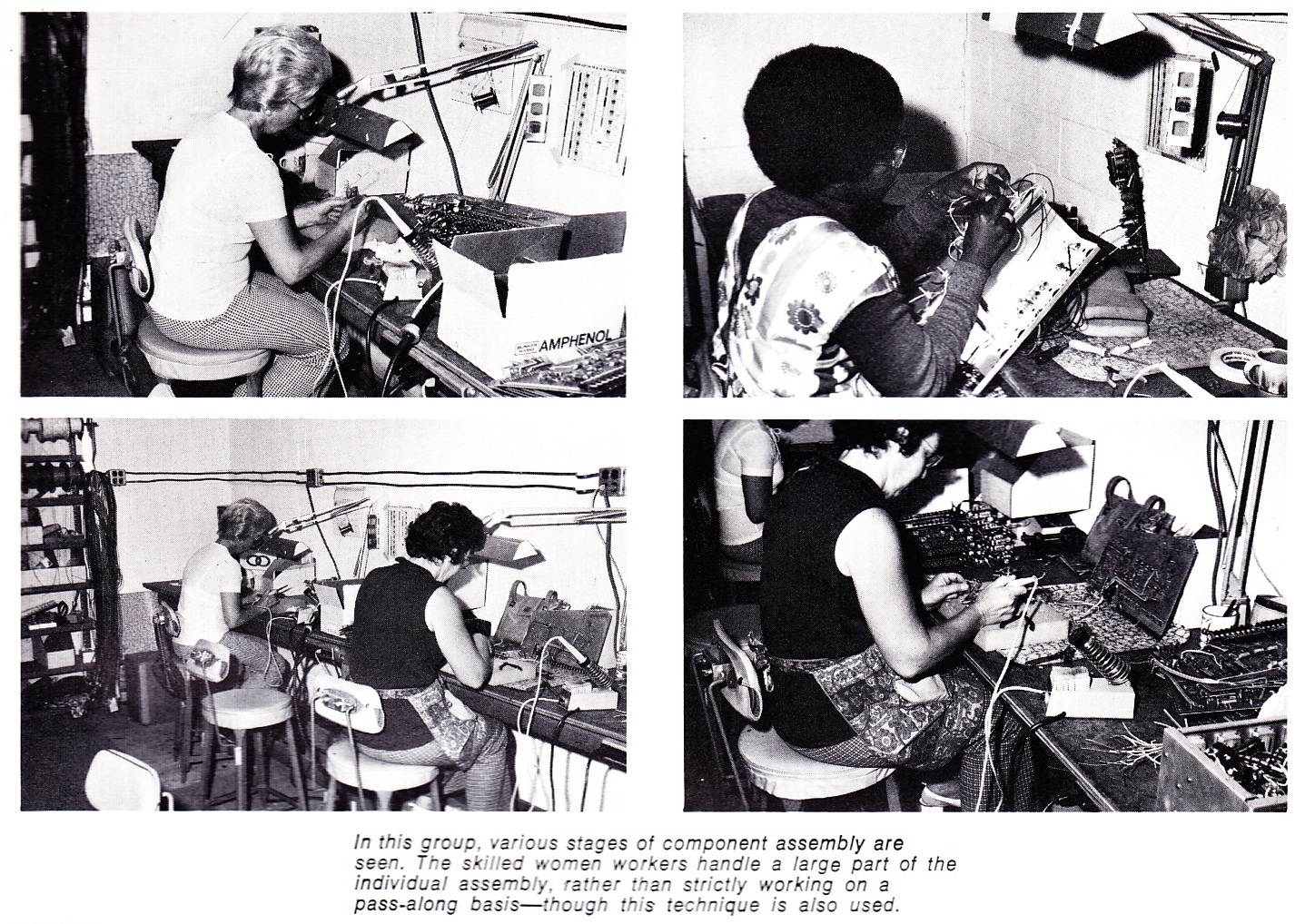 If there are any Gately alums out there, drop us a line; and if anyone out there is using any of this Gately kit, please let us know your thoughts. I have yet to use my EM7 and EQ7 on a production, but at some point I hope to be able to do a shoot-out versus some better-known contemporary units such as API and Neve.
If there are any Gately alums out there, drop us a line; and if anyone out there is using any of this Gately kit, please let us know your thoughts. I have yet to use my EM7 and EQ7 on a production, but at some point I hope to be able to do a shoot-out versus some better-known contemporary units such as API and Neve.
*************
*******
***
From PS dot com reader J. Roberts:
“I have a Gately Prokit II that I bought from Bob Todrank back around 1976. Bob had one of the first audio businesses in Berry Hill.
The mixer still works, no repairs ever, factory wired, I think it may be something like serial # 101w, but I will have to look and see. I kept a search on ebay for Gately and finally something surfaced… an original manual for my mixer.
I like that mixer because it is simple, no eq or anything to mess up, just set levels and pan. Interesting that the headphone out has no volume control, but I bought an old pair of Koss with faders just to use with that mixer. It looks to have very high quality components. I do not know about ICs, wondering if the ones in there are ok or should be upgraded. Does not have the output transformer option either. In a day or two I plan to feed a Coopersound micpre into the line ins and see what I get. I guess I should lay down some tracks and make another classical guitar LP, as I did back around 1978. Mastered at NRP by Larry Boden. Very fun times.”
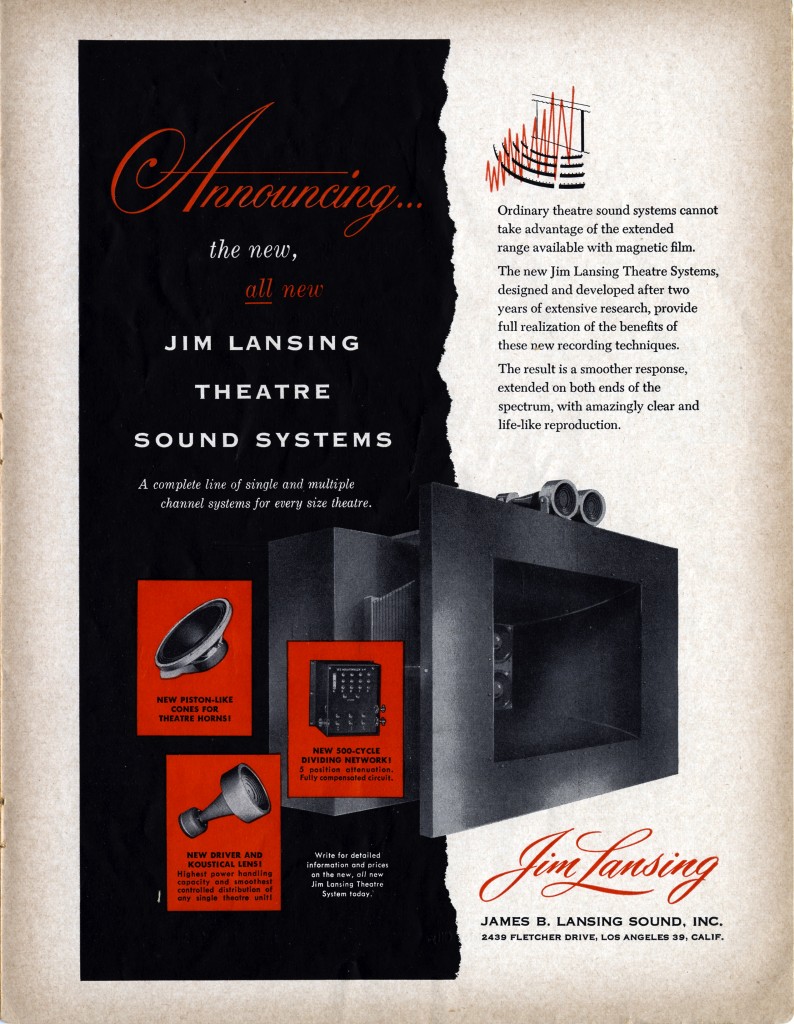 Today: some random bits+bobs of Sound-For-Film technology of the early 1950s. Above: the All-New JBL Theatre Sound Systems, which claim to offer the higher-fidelity needed to properly reproduce the newly-available magnetic soundtracks that were being used in 35mm film at the time. Prior to the introduction of magnetic 35mm film soundtracks in the 1950s, all film-sound was reproduced in theaters via an optical sound-track which ran alongside the edge of the film-frames. Fidelity was limited, although I cannot say exactly to what frequency range. Can anyone tell us what the first feature-film was to be exhibited nationwide with a magnetic soundtrack?
Today: some random bits+bobs of Sound-For-Film technology of the early 1950s. Above: the All-New JBL Theatre Sound Systems, which claim to offer the higher-fidelity needed to properly reproduce the newly-available magnetic soundtracks that were being used in 35mm film at the time. Prior to the introduction of magnetic 35mm film soundtracks in the 1950s, all film-sound was reproduced in theaters via an optical sound-track which ran alongside the edge of the film-frames. Fidelity was limited, although I cannot say exactly to what frequency range. Can anyone tell us what the first feature-film was to be exhibited nationwide with a magnetic soundtrack?
Above: Cinema Engineering presents… the fader! Straight-line attenuators have certain advantages over rotary controls, such as quicker visual feedback and a range of motion that better correlates with human bio-mechanical consideration. Nonetheless, rotary faders remained in use in pro audio well into the late 60s. Does anyone know who first patented and/or marketed the linear fader?
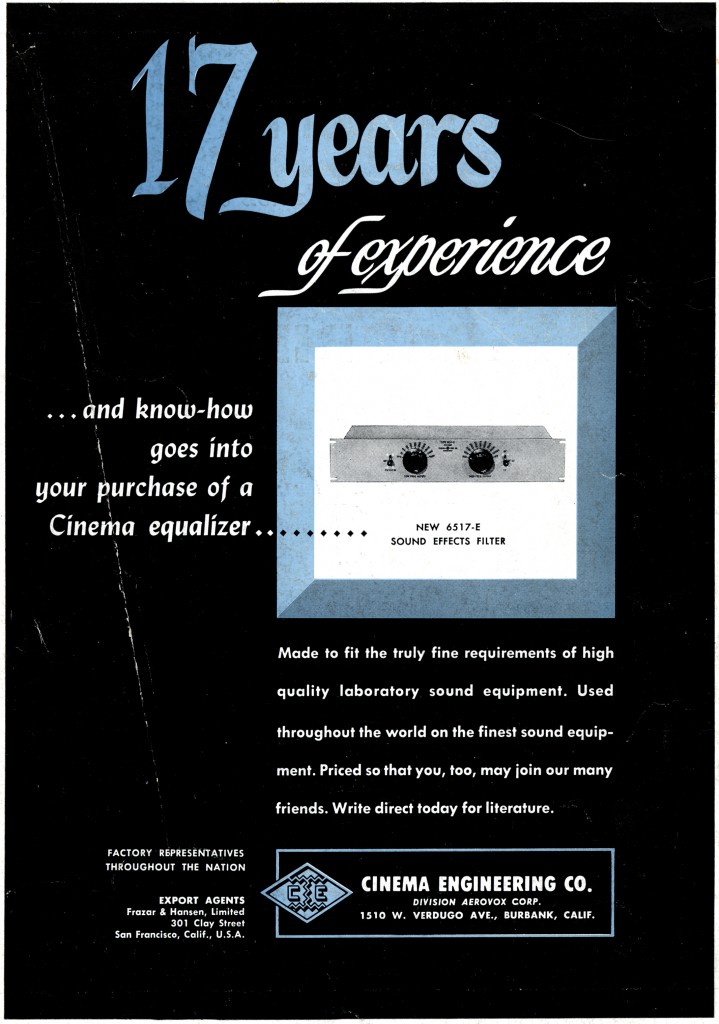 Above: the Cinema Engineering 6517-E ‘Sound Effects Filter,’ aka a high-pass and a low-pass filter both built into a single instrument. I could find this sort of thing very useful; especially for tracking multiple ‘stacked’ parts such as one singer delivering 7 vocal harmonies over a single phrase, as I found myself doing in a session earlier this week. Just carve out all of the unnecessary super-high and super-low end… the 80 or 100 hz high-pass filter built into many mic preamps is certainly useful but it’s obvs not always the best cut off choice.
Above: the Cinema Engineering 6517-E ‘Sound Effects Filter,’ aka a high-pass and a low-pass filter both built into a single instrument. I could find this sort of thing very useful; especially for tracking multiple ‘stacked’ parts such as one singer delivering 7 vocal harmonies over a single phrase, as I found myself doing in a session earlier this week. Just carve out all of the unnecessary super-high and super-low end… the 80 or 100 hz high-pass filter built into many mic preamps is certainly useful but it’s obvs not always the best cut off choice.
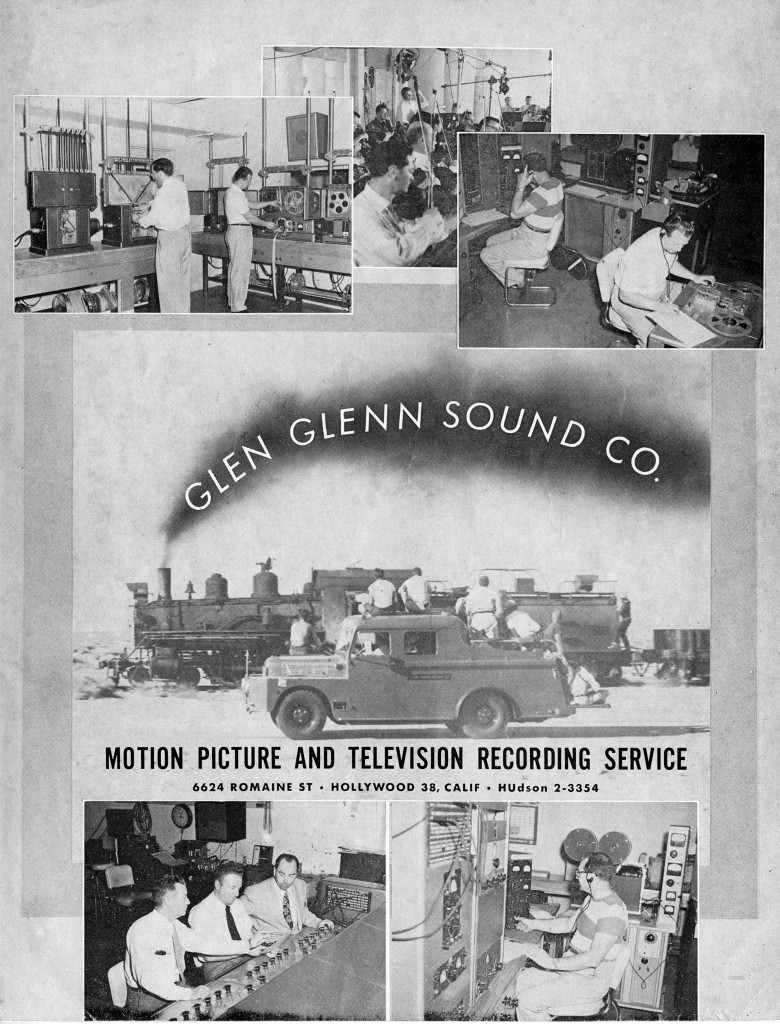 Above: an advert for Glen Glenn Motion Picture Sound Co. circa 1953. Anyone out there work for this firm? We’d love to hear yr stories…. drop us a line…
Above: an advert for Glen Glenn Motion Picture Sound Co. circa 1953. Anyone out there work for this firm? We’d love to hear yr stories…. drop us a line…
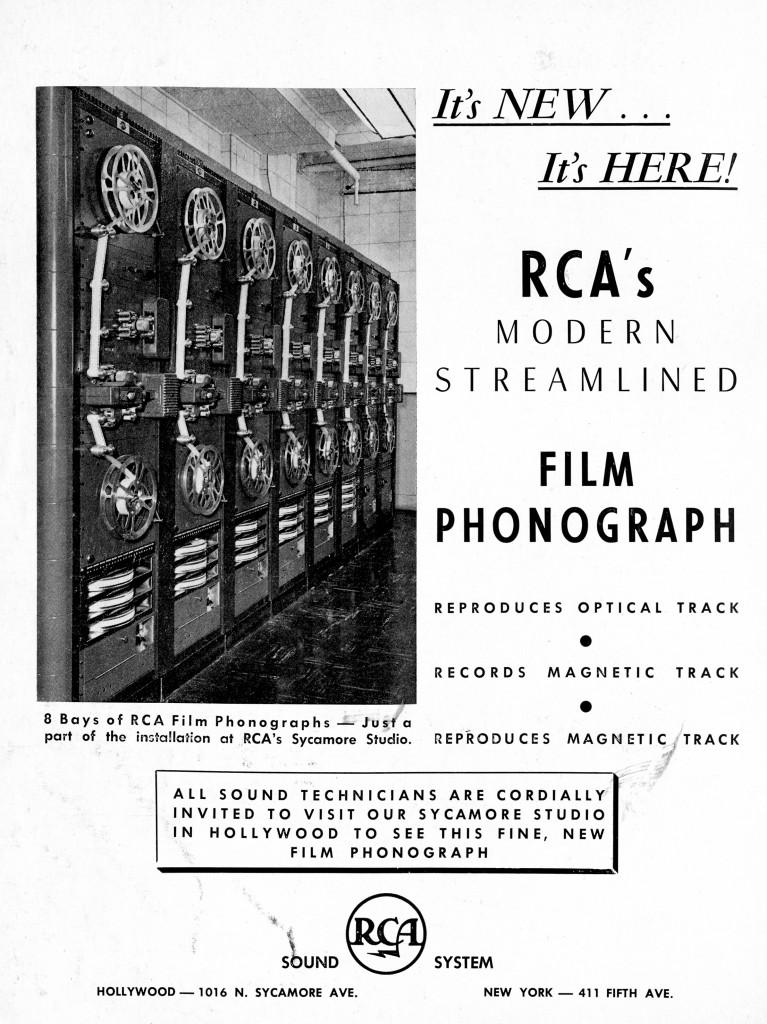 Above: RCA’s ‘film phonograph,’ an apparatus that records and plays-back 35 mm magnetic sound-tracks and plays-back 35mm optical sound tracks as well. I ended up with a couple of 16mm sound track readers at Gold Coast Recorders; not sure what to do with them. Has anyone had any luck converting an optical-track reader into a signal processing or signal generating device? Seems like there’s some potential to make it into interesting experimental instrument; strobe-light-controlled oscillator perhaps?
Above: RCA’s ‘film phonograph,’ an apparatus that records and plays-back 35 mm magnetic sound-tracks and plays-back 35mm optical sound tracks as well. I ended up with a couple of 16mm sound track readers at Gold Coast Recorders; not sure what to do with them. Has anyone had any luck converting an optical-track reader into a signal processing or signal generating device? Seems like there’s some potential to make it into interesting experimental instrument; strobe-light-controlled oscillator perhaps?
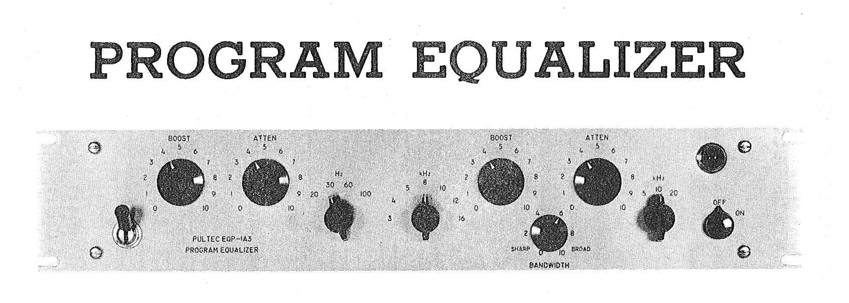 Download the complete twelve-page 1977 Pultec outboard audio equipment catalog:
Download the complete twelve-page 1977 Pultec outboard audio equipment catalog:
DOWNLOAD: Pultec-1977_catalog
Units covered, with text, specs, and photos, include: Pultec EQH-2, EQP-1A3, and MEQ-5 equalizers; Pultec HLF-3c and HLF-26 filters; Pultec SP3 and MH4 mixers.
 Until I saw this catalog I had not realized that the original Pultec production run had extended into 1977. These are the solid-state Pultecs, not the more coveted vacuum tube units that trade in the $5000 range, but AFAIK the actual equalization stages are the same as in the earlier tube units. I have never scratch-built a Pultec clone, largely because the idea of hand-building the multi-tapped inductors always seemed a little daunting to me. I recently found myself in possession of a large batch of various MiniDuctors, though, and I am wondering if these can be put service in a Pultec-type circuit. The mH values are very close to those in the putlec schematics, but I cannot find any reference online to anyone building a Pultec using MiniDuctors rather than a large coil-wound inductor. Anyone have any idea about this?
Until I saw this catalog I had not realized that the original Pultec production run had extended into 1977. These are the solid-state Pultecs, not the more coveted vacuum tube units that trade in the $5000 range, but AFAIK the actual equalization stages are the same as in the earlier tube units. I have never scratch-built a Pultec clone, largely because the idea of hand-building the multi-tapped inductors always seemed a little daunting to me. I recently found myself in possession of a large batch of various MiniDuctors, though, and I am wondering if these can be put service in a Pultec-type circuit. The mH values are very close to those in the putlec schematics, but I cannot find any reference online to anyone building a Pultec using MiniDuctors rather than a large coil-wound inductor. Anyone have any idea about this?